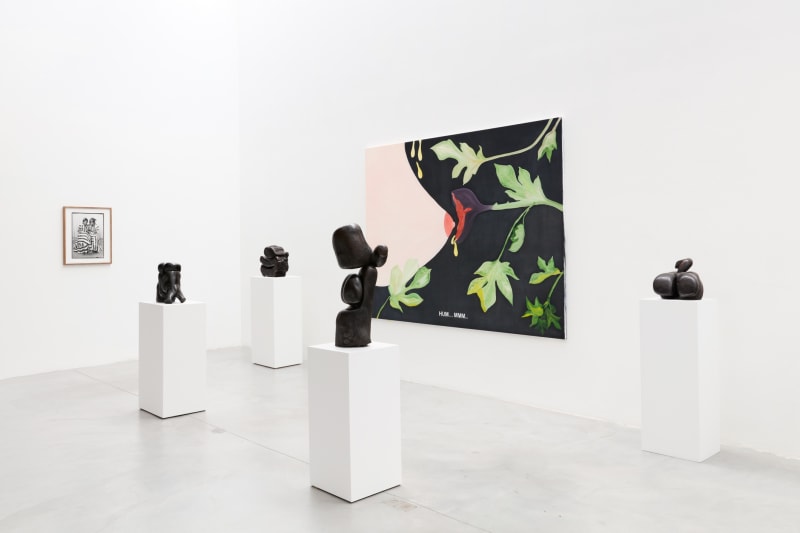Galerie Nathalie Obadia is delighted to announce the group exhibition Wang Keping et le corps représenté, showcasing artworks by eleven of the gallery's artists. Wang Keping's sculptures are placed in dialogue with photographs, drawings, and other sculptures, all revolving around a common theme: the human body. While some of the artworks depict the body directly, others suggest it, going so far as to reveal, through shapes and colours, the diversity of emotions that can run through it. In this way, this exhibition presents the body through the lens of contemporary artists, offering a poetic exploration of its many facets.
Wang Keping's many and varied sculptures stand out among the works in the exhibition. The refined forms of the artist, born near Beijing in 1949, resonate closely with the Chan philosophy of meditation, withdrawal, and detachment. The curves and rounded lines suggest the body, either on its own or in company, carved in wood or cast in bronze. For Wang Keping, trees are like human bodies 'with hard parts like bones, tender parts like flesh, sometimes resistant, sometimes fragile', says the artist, before adding, 'I can't go against it (the material). All I have to do is follow it so that it agrees to be my accomplice'. The close, even carnal, relationship between the artist and his work gives rise to bodies that seem to emerge from the very material. The wood is meticulously crafted, and the visible rings and cracks bear witness to the material's evolutionary power, a process Wang Keping is intimately familiar with. This finish lends every surface the appearance of real skin, of flesh being formed in the living material. The articulations of rounded shapes, meticulously balanced masses and sinuous veins imbue the sculptures with a sensuality reminiscent of the female form. The erotic dimension emerges from the voluptuous forms that intertwine, sometimes losing themselves in the material and melding together, like lovers in an embrace. In this manner, the couples merge into one, becoming lost in each other and the loving sentiment that may flow between them. These 'dialogues' between the bodies might also resonate with the evocatively titled Conversation (1998) by artist Roger-Edgar Gillet. The two subjects are depicted together, their exchanges appearing to blend seamlessly in the oil painting.
As such, the exhibition highlights the semantic potency of the body as perceived by contemporary artists. The way it is positioned in the space, its proximity to other subjects, and the different garments and other accessories worn provide us with clues about the protagonists. The language of the body is explicit, as seen, for instance, in the work of Agnès Varda: the physical contact between the young woman and the two infants could symbolize maternity, portraying a mother accompanied by her two children. Seydou Keïta's work, on the other hand, is more theatrical, revealing the social status of the subjects photographed through their posture or chosen clothing. The artist directs our gaze, weaving narratives through the manipulation of bodily expression. These poetic openings are also found in the absent body, symbolised by an imprint, a draping or its cast. While bare breasts and other body parts are left fully uncovered in the work of Laure Prouvost and Andres Serrano, in the work of Sophie Kuijken, their contortions are evoked through floating fabric. The drapery effectively manages to substitute the entire body in Guillaume Leblon's work; the cloak emerging as a trace of a phantom presence, now vanished.
How can the body be represented today? How do works of art contribute to the creation of identities? This issue lies at the heart of our modern societies. Jérôme Zonder focuses on the portrait of Pierre-François - a fictitious character borrowed from Marcel Carné's film Les Enfants du Paradis (1945) - and explores the facets of this allegorical figure in such a way as to grasp, through it, the full complexity of the issues surrounding portraiture and drawing. Hoda Kashiha's painting and Antoine Renard's sculpture explore the figure of the body in the political and social context in which it evolves. Antoine Renard, for example, takes the silhouette of Donatello's David - a body that has long been idealised - and reworks it using telluric, digital and chemical elements. These combinations give rise to asperities in the slender silhouette, bringing all its complexities up to date in contemporary society. These reflections explore the body as an object subjected to industrialised, mechanised and spectacularised production systems.
In this way, the exhibition unveils a transformed body, gradually liberated from the aesthetic canons of yesteryear. The sculptures of Wang Keping further enhance this reinterpretation, as the body becomes simultaneously the tool, the trace, and the imprint within the deployed forms.
With works by Wang Keping, Jérôme Zonder, Agnès Varda, Andres Serrano, Antoine Renard, Laure Prouvost, Guillaume Leblon, Sophie Kuijken, Seydou Keïta, Hoda Kashiha and Roger-Edgar Gillet.











